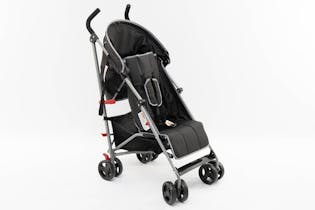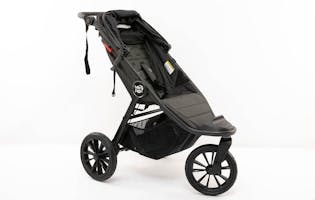Strollers
Find the best stroller with our buying guide and test results for 49 current and 61 discontinued models.
We test each stroller against some aspects of the Australian/New Zealand standard (AS/NZS 2088:2013). Our testing is particularly important because compliance with the standard isn’t mandatory in New Zealand.
Overall score breakdown
Overall score is based on:
Safety score (50%): In our stroller safety assessment, conducted to the AS/NZS 2088:2013 standard, we look for hazards to the child and the carer using the stroller. Major failures include insufficient child retention, strangulation hazards, poor stability (tipping), head entrapment hazards and structural durability failures.
- 100% = no major or minor failures.
- 80% = 1 minor failure.
- 70% = 2 minor failures.
- 60% = 3 or more minor failures.
- 40% = 1 major failure.
- 20% = 2 or more major failures.
Ease of use (50%): Strollers are put through their paces in real life. We check how easy it is to adjust the safety harness, seats and handle. We apply the brakes and access the bottom basket. We push them over rough terrain, up and down stairways and through doorways. We fold and unfold them, carry them and lift them into and out of a car boot.
Durability: All strollers are attached to a machine that continuously simulates the action of mounting a kerb. This shows whether anything breaks, falls off or stops working properly after regular use.
For brands we haven’t tested before we put the strollers on a bumpy “rolling road” machine for 64 hours at a speed of 5km/h. Strollers suitable for jogging get an extra 10 hours at 10km/h on the rolling road to see how they stand up to faster speeds.
We also put models that look flimsy or have something different about it through the “rolling road” test. We used to do the “rolling road" test for all models but we rarely find models that fail this test.
Durability does not contribute to overall score.
To earn our recommendation, a single stroller must have an overall score of 70%, double strollers must have an overall score of 65%. We don’t recommend strollers with any major safety or durability failures.
The standard
The 2009 revision of this standard added a requirement that the harness straps shouldn't be a strangulation hazard when they're buckled together. This followed a fatal case in 2005 when a child slipped through such a gap and was caught. The buckled-together harness straps are especially hazardous if:
- A child's left unattended in the stroller.
- The harness is kept buckled when it's not in use.
The 2013 standard is largely the same as the 2009 version - but it's been extended to cover finger entrapment, crushing/scissoring hazards for adult users (or for children outside the stroller) and stability. There's also further emphasis on harness requirements. While compliance with this standard is not mandatory in New Zealand, we think it should be. We believe AS/NZS 2088:2013 sets a clear and reasonable safety standard. We’d like to see all manufacturers constructing their strollers to the updated standard – as some of them already do. In Australia, compliance with some requirements of AS/NZS 2088 is compulsory.
We've tested 110 strollers.
Find the right one for you.
Anko

Baby Jogger

Baby Jogger
.jpg&w=315&q=75)